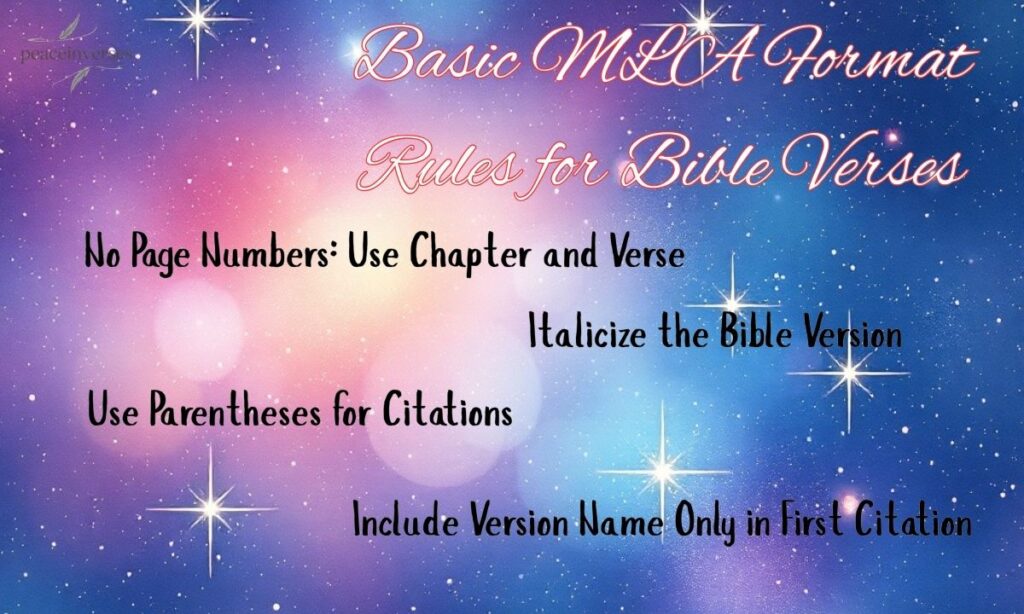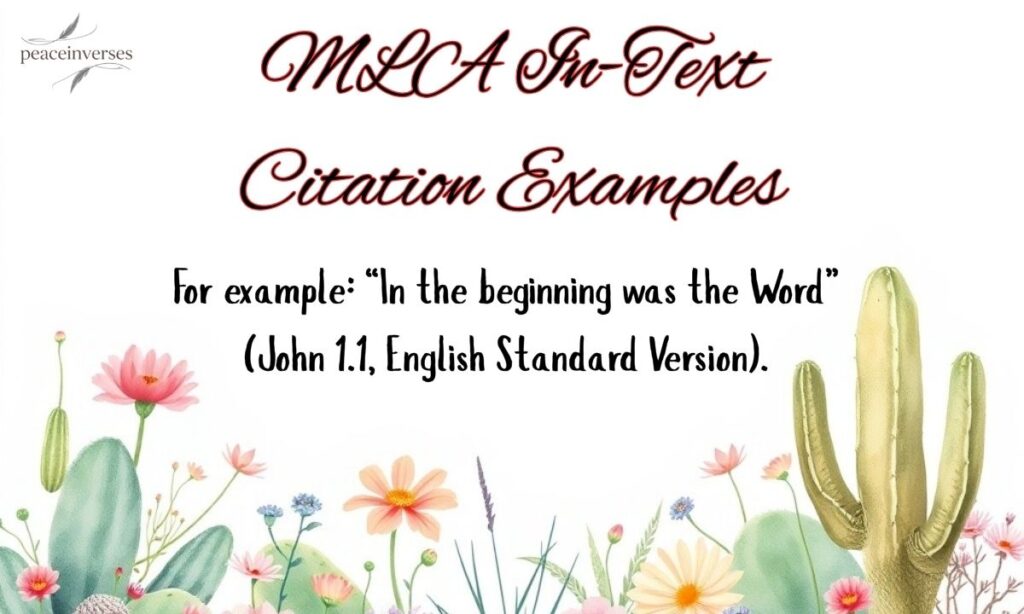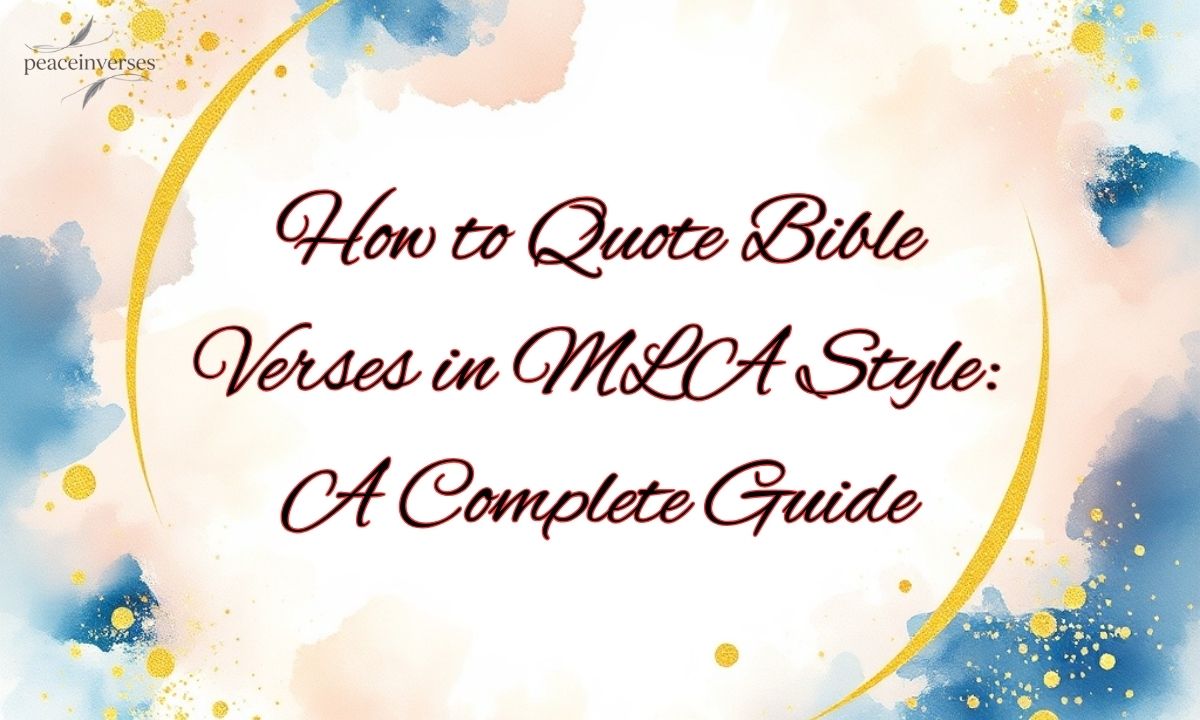Quoting the Bible in MLA style might sound simple, but one small mistake can change the meaning of your work. Many students feel nervous when citing Scripture because the rules look different from other sources. Getting it right shows both respect for the text and strong academic skills.
When writing essays or research, accuracy is more than a requirement—it’s your credibility. The MLA format has clear rules for quoting Bible verses, yet many overlook the details. With the right approach, you can cite verses with confidence and clarity every time.
Why MLA Bible Citation Matters
Quoting the Bible in MLA style ensures clarity and accuracy in academic writing. It guides readers to the exact book, chapter, and verse. Proper citation also shows respect for the sacred text. Without it, your work may lose trust and credibility.
Importance of Accurate Citation
Accurate citation is key to academic honesty. It shows that your arguments are supported with clear sources. Professors value this practice because it prevents plagiarism. Every correct reference adds weight to your work.
Precise citation also avoids misunderstanding and confusion. The Bible has many versions, and wording often changes. MLA style ensures your audience knows which translation you use. This accuracy makes your writing stronger and more reliable.
Example of MLA Bible Citation
For example, if you are citing Romans 8:28 from the English Standard Version, it should appear like this:
“And we know that for those who love God all things work together for good…” (English Standard Version, Rom. 8.28).
This method puts the translation name first, followed by book, chapter, and verse. It keeps your citation consistent and professional. Using this style builds both clarity and trust in your work.
Basic MLA Format Rules for Bible Verses

The Bible in MLA style has special rules for citation. These rules make your writing professional and consistent. They also help readers find verses quickly and clearly.
No Page Numbers: Use Chapter and Verse
In MLA style, you never use page numbers when citing the Bible. Instead, write the book name, chapter, and verse like this: (John 3.16). This keeps your work clear across all editions.
Page numbers change depending on the Bible printing. But chapters and verses stay the same everywhere. That is why MLA requires you to use them instead of page references.
Italicize the Bible Version
Always italicize the version name of the Bible. For example: New International Version or King James Version. Italics make the version stand out from the verse reference.
Using italics helps readers see the translation instantly. Because wording varies between versions, this small detail is very important. It adds clarity and looks professional in your writing.
Use Parentheses for Citations
Bible verses should always appear in parentheses after the quotation. Example: “The Lord is my shepherd” (Ps. 23.1, New King James Version). This keeps your source linked to your text.
Parentheses show a direct connection between your quote and citation. They prevent confusion and let your argument flow smoothly. Readers can see your reference without distraction.
Include Version Name Only in First Citation
You should include the version name only in your first citation. Example: (Gen. 1.1, English Standard Version). After this, just use the book, chapter, and verse.
This avoids repeating the version name in every reference. It makes your paper cleaner and easier to read. If you switch to a new translation, cite that version clearly.
MLA In-Text Citation Examples

Citing the Bible in MLA style requires precision and consistency. In-text citations point readers to the exact verse and translation. Different examples help show how to format properly. Following these rules keeps your work accurate and professional.
Standard Citation Example
The most common way to cite is the standard format. For example: “In the beginning was the Word” (John 1.1, English Standard Version). This format includes book, chapter, verse, and translation. It is clear and works in any academic paper.
Using the standard format shows your attention to detail. Readers know exactly where to find the verse and which version you used. This method is best when you are quoting multiple passages in one essay. It keeps everything clear and consistent.
Abbreviated Citation Example
MLA also allows abbreviations for Bible books in parentheses. For example: (Jn. 1.1, ESV). Abbreviations are useful in longer papers with many verses. They save space while staying accurate.
Still, MLA suggests writing the full book name in the sentence itself. Example: In John 1.1, the verse says… then abbreviate in the citation. This balance keeps writing smooth and professional while saving room in references.
Multiple Translations
Sometimes writers use more than one Bible translation. In this case, MLA requires that you name each version clearly. For example: (John 3.16, New International Version) and later (John 3.16, King James Version). This avoids confusion between translations.
If you use multiple translations often, signal the version in the text before quoting. Example: The King James Version states…. This makes it easy for readers to follow along. Switching without clarity can weaken your essay’s authority.
How to Cite the Bible in the Works Cited Page

Citing the Bible in MLA style requires a full entry on the Works Cited page. The format depends on whether you use a print edition or an online version. Each citation must include the translation, publication details, and year. Following these steps ensures accuracy and professionalism.
Citing Print Bibles
When citing a print Bible, MLA requires the version title in italics, the editor (if listed), publisher, and year. Always start with the translation as the main title. This makes the entry consistent with other MLA book citations.
For example, the format is: Title of the Bible. Edited by Editor’s Name (if available), Publisher, Year.
- Format: The Holy Bible, New International Version. Zondervan, 2011.
- Example: The Holy Bible, English Standard Version. Crossway Bibles, 2001.
Citing Online Bibles
When citing an online Bible, you include the italicized version name, website, publisher, publication year, and URL. If no publication year is given, use the access date. Always make sure the translation is clear.
For example, the format is: Title of the Bible. Publisher, Year, URL.
- Format: The Holy Bible, New Living Translation. Tyndale, 2015, www.biblegateway.com.
- Example: The Holy Bible, King James Version. Bible Gateway, 2019, www.biblegateway.com.
Common Mistakes to Avoid When Citing the Bible
Citing the Bible in MLA style can be tricky if you’re not careful. Small errors can make your work look unprofessional. Avoiding common mistakes ensures clarity and credibility. Correct formatting also shows respect for both Scripture and academic standards.
Don’t Use Page Numbers
One common mistake is using page numbers instead of chapter and verse. For example, citing a verse as (p. 45) is incorrect. MLA requires book name, chapter, and verse only. This keeps your reference universal across all Bible editions.
Using page numbers can confuse readers because editions vary widely. Chapters and verses remain the same in every Bible. Correct citation makes it easy for anyone to locate the verse. Avoid page numbers to maintain accuracy and clarity.
Italicize Versions Correctly
Another common error is failing to italicize the Bible version. The translation name, such as New International Version, should always be in italics. This separates it from the verse reference and maintains professional formatting.
Incorrect italics can make your citation look careless. Proper formatting signals attention to detail and helps readers know exactly which translation you used. Always double-check that the version is italicized in every citation.
Frequently Asked Questions
How to Quote a Bible Verse in MLA?
To quote a Bible verse in MLA, include the book, chapter, and verse in parentheses. Example: “For God so loved the world” (John 3.16, New International Version). Always italicize the version name.
Make sure to cite the first reference fully if using the version for the first time. Subsequent citations can omit the version unless switching translations. This keeps your writing clear and consistent.
How to Cite a Bible Verse with a Quote?
Place the Bible verse in quotation marks and follow it with an in-text citation in parentheses. Example: “The Lord is my shepherd” (Ps. 23.1, King James Version).
Ensure the punctuation comes after the parentheses. Include the version only on the first citation or when switching translations. This maintains proper MLA formatting.
How to Cite a Bible Dictionary in MLA
When citing a Bible dictionary, list the author or editor, title in italics, publisher, and year. Example: Holman Bible Dictionary. Holman Bible Publishers, 2011.
Use MLA formatting consistently for all reference works. Include page numbers if quoting a specific entry. This ensures your sources are clear and traceable.
How to Cite Religious Texts in MLA?
For other religious texts, treat them like the Bible in MLA. Include title, editor or translator, publisher, year, and version if applicable.
Always provide enough detail for readers to locate the source accurately. Follow MLA guidelines for consistency and professional formatting.
How to Quote Bible Verses from the KJV?
Use the King James Version like any other Bible version. Example: “In the beginning God created the heaven and the earth” (Gen. 1.1, King James Version).
Italicize the version name and use chapter and verse, not page numbers. Include the version only in the first citation unless switching translations.
How to Quote Online Bible Verses in MLA?
Include the translation, website name, publisher, year, and URL for online Bible quotes. Example: “For I know the plans I have for you” (Jer. 29.11, New International Version, Bible Gateway, 2019, www.biblegateway.com).
Use MLA formatting consistently and include the access date if no publication year is available. This ensures readers can verify the source online.
NIV Bible Citation in MLA?
For the New International Version, cite like any print or online Bible. Example: “Trust in the Lord with all your heart” (Prov. 3.5, New International Version).
Italicize the version name and include chapter and verse. If quoting online, add the website and access details following MLA guidelines.
Final Thoughts
Citing Bible verses correctly in MLA style strengthens both credibility and clarity. Using proper formatting ensures your readers can locate passages easily. Accuracy in chapter, verse, and version demonstrates academic integrity.
Consistency is key in MLA Bible citations. Whether using print or online versions, follow the rules carefully. Proper citation shows respect for Scripture and keeps your work professional and polished.

